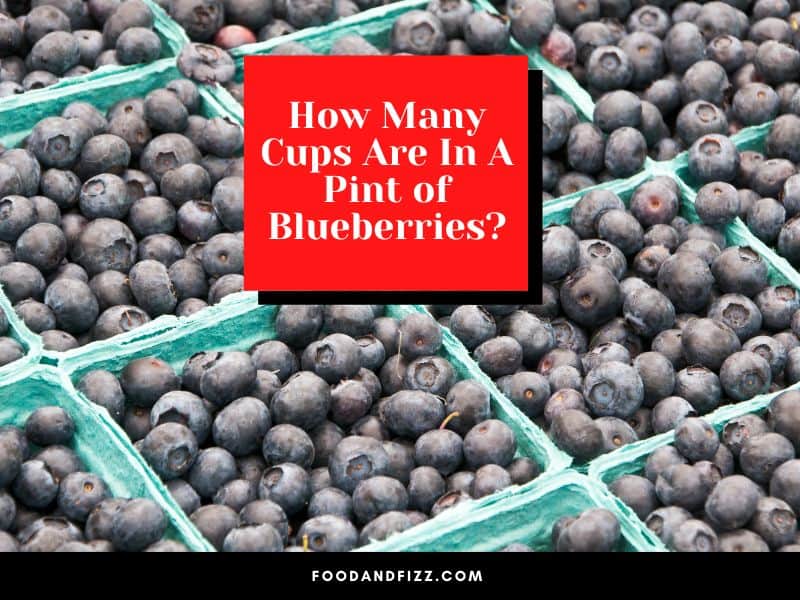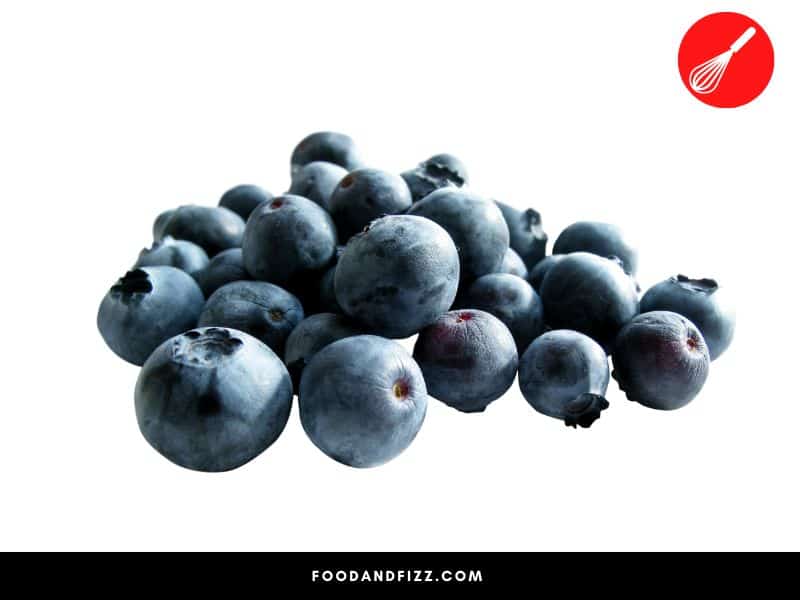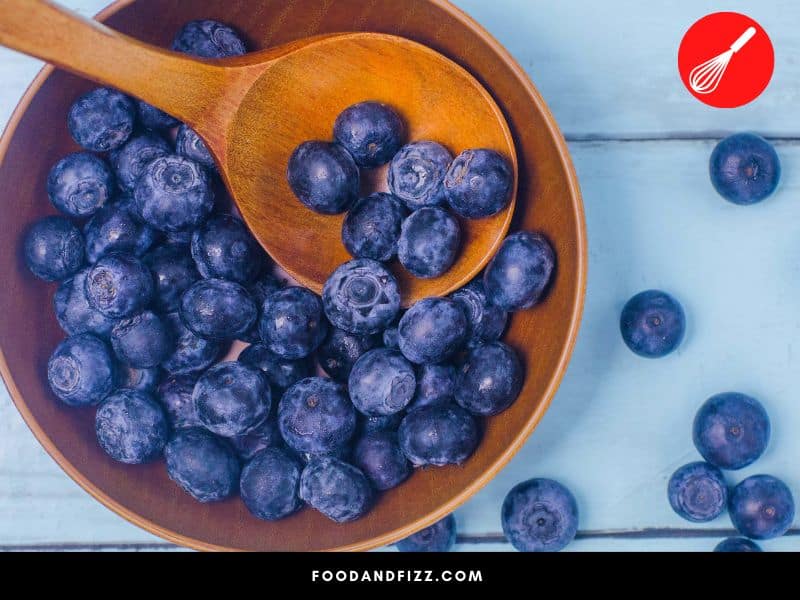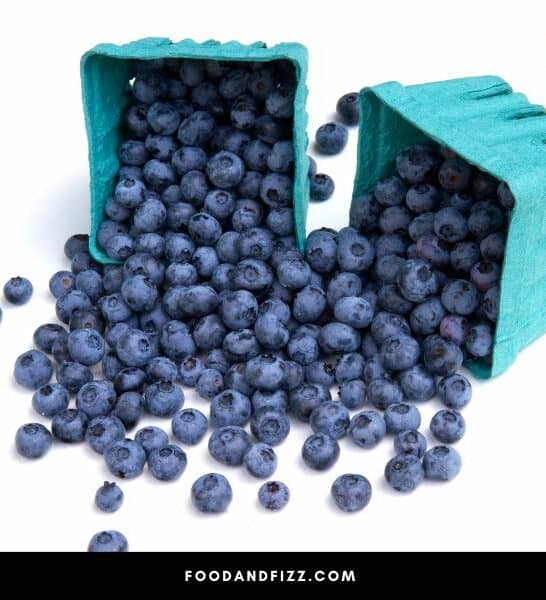Converting kitchen measurements is something that all cooks and bakers have to deal with the more they spend time in the kitchen.
Whether it’s converting from metric measurements to the U.S. customary units of measure or the other way around, or converting from one customary volume unit of measure to another, some form of conversion seems to always be necessary to get through most recipes.
One such conversion that we often encounter is the conversion from pints to cups and vice versa. Sometimes, the conversions can be pretty straightforward such as when dealing with liquid ingredients. In other ways though, like when we deal with fruit that can vary in physical size, it can be less straightforward.
So for example, how many cups are in a pint of blueberries?
How Many Cups Are In A Pint of Blueberries?
In a pint of blueberries, there are about 2 cups of blueberries. Dry pints are a measure of capacity, not weight, so the actual size of the blueberries and the space between them when measuring them in cups could influence how many cups are measured from the pint. The size of the measuring cup used can also influence the figure, but it would not be a drastically different number from 2 cups.

What Is A Pint?
A pint is a unit of measurement that measures the capacity or volume of a given container, or how much of an ingredient it can hold. In the U.S, there is what is called a dry pint and a liquid pint.
Liquid pints measure the volume of liquid ingredients, and dry pints measure dry ingredients like fruits. Liquid pints are equal to 16 fluid ounces, which are also a unit of volume. Both dry pints and liquid pints equal 2 standard U.S. cups.
How Many Cups Are in A Pint of Blueberries?
A dry pint of blueberries is equal to 2 cups. Or to answer our question more directly, there are 2 cups in a pint of blueberries. This is a pretty reliable standard to use, however, if you go out and buy a pint of blueberries and test this yourself, you may find that sometimes a dry pint of blueberries may yield a few more extra berries and can come out to a little over 2 cups.

The Size of Your Blueberries Can Affect The Measurement
This is because a pint is a unit of capacity, not weight, and if the size of your blueberries are all different, they may not all fit in the cup measure in the same way.
If you have some bigger blueberries mixed in with smaller blueberries, the bigger blueberries will take up more space in the measuring cup, which may be the reason why you can sometimes have some extra berries.
The Size of Your Measuring Cups Can Influence The Result
The particular size and brand of your measuring cups can also influence whether your dry pint of blueberries will come out to exactly 2 cups. Believe it or not, not all measurement cups are created equal.
Depending on the brand and who manufactures it, they can have slight variations in capacity, and when dealing with blueberries that are whole and round in shape, and can take up more space than say, flour, this can be more readily apparent.
I own two different measuring cup sets, one stainless and one plastic. The plastic ones are a bit thicker and hold a little bit less of the ingredients. Not significant, but comparing them side by side you surely will notice the difference. If I use them to measure blueberries, they may yield slightly different results.
However, in the grand scheme of things, the differences are not all that significant. If your recipe calls for a pint of blueberries, or two cups, having a few extra blueberries in there is not likely to affect your recipe in a negative way.
For example, if you’re making blueberry pancakes or a blueberry smoothie, more blueberries will just make your recipe more delicious!

How Many Ounces of Blueberries Are In A Pint?
Ounces are a unit of weight, not of capacity or volume. If your recipe is written using weight units, it is important to know how many ounces there are of blueberries in one pint.
A tray or crate of blueberries is normally referred to as a flat of blueberries. A flat of blueberries usually contains 12 pints, and according to the chart compiled by the University of Georgia Extension, weighs anywhere from 9-12 pounds. Given this figure, we can say that a pint of blueberries weighs anywhere from 12-16 ounces.
How Many Pounds of Blueberries Are In A Pint?
One pound is equal to 16 ounces. If there are 12-16 ounces of blueberries in one pint, we can say that there are about ¾ pound to 1 pound in one pint of blueberries.
How Many Ounces in One Cup of Blueberries?
There are two cups in one pint, so if one pint contains 12-16 ounces of blueberries, we can say that there are 6-8 ounces of blueberries in one cup.
How Much Is One Cup of Blueberries in Grams?
One cup of blueberries would weigh on average about 148 grams, although related to what we mentioned earlier, this may vary depending on the size of the blueberries and how much of it will fit in a cup.

USEFUL CONVERSIONS FOR BLUEBERRIES
| Blueberry Amount | Equivalent In Various Units |
| 1 Pint | 2 cups |
| 1 Pint | 12 - 16 ounces |
| 1 Pint | 0.75 - 1 pound |
| 1 Cup | 6 - 8 ounces |
| 1 Cup | 150 grams |
| 1 Quart | 4 cups |
| 1 Gallon | 16 cups |
| Source: University of Georgia Extension |
How Many Calories Are in One Cup of Blueberries?
As we mentioned earlier, cups as a unit of measure may not be as accurate as it would depend on the size of the blueberries. However, on average, the Blueberry Council states that one cup of fresh blueberries is equal to about 148 grams and that one cup of blueberries is equal to 80 calories.
Are Blueberries Healthy?
Blueberries are an extremely healthy fruit that is an abundant source of vitamins and minerals like vitamins C and K, and manganese which are all important for many vital processes in the body.
Vitamin C promotes immunity and promotes healing, while vitamin K is important for the health of our bones as well as for blood clotting. Manganese helps with the processing of carbohydrates, amino acids and helps our body produce energy. It helps with vital processes that protect our cells from being damaged.
Blueberries contain significant amounts of dietary fiber which promotes gut health and helps with weight loss.
Blueberries are also rich in anthocyanins, which are antioxidants that protect us from free radicals that may wreak havoc and contribute to aging and cell death.
Anthocyanins are what give food their red, blue, and purple pigments and blueberries are an abundant source of this group of compounds.
These antioxidants have also been shown to ward off cancer.
And lastly, as we mentioned earlier, blueberries are naturally low in calories and can boost our efforts to eat a healthy diet.
NUTRITIONAL PROFILE OF BLUEBERRIES
| (per 1 cup or 148 g serving) | ||
| % Daily Value | ||
| Calories | 80 | |
| Total Fat | 0.5 g | 1% |
| Cholesterol | 0 g | 0% |
| Sodium | 0 g | 0% |
| Total Carbohydrates | 21 g | 8 % |
| Dietary Fiber | 4 g | 14 % |
| Total Sugars | 15 g | |
| Protein | 1 g | |
| Iron | 0.4 mg | 2% |
| Potassium | 110 mg | 2% |
| Vitamin C | 14 mg | 15% |
| Manganese | 0.5 mg | 20% |
| Vitamin K | 29 mcg | 25% |
| Source: U.S. Highbush Blueberry Council |
What Can I Do With Blueberries?
Blueberries are pretty versatile and there are a lot of things you can do with them, from pancakes to muffins, to smoothies and pies. You can also use it to infuse cocktails, make it into a syrup or add them to your salads.
When baking with blueberries, The U.S. Highbush Blueberry Council advises taking some precautions to ensure that your blueberry baked goods will turn out the way the recipe intended.
For fresh blueberries, they advise tossing the blueberries in a tablespoon of flour prior to adding them to your batter. This is so that they won’t sink in your cakes and muffins, and will remain evenly distributed throughout the batter.
For frozen blueberries, they advise rinsing in water first until the water becomes light and drying the berries with paper towels. This step prevents them from bleeding into your batter.
In both cases though, they advise gently stirring the berries to prevent bursting and bleeding.

Frequently Asked Questions to How Many Cups Are In A Pint of Blueberries?
How Many Blueberries Are in ¼ Cup?
If there are 148 g or 5.2 oz of blueberries in one cup, there are 37g or 1.3 oz in ¼ cup. The number of blueberries would depend on the size of each individual berry.
How Many Calories Are In One Cup of Blueberries?
A 148 g serving of blueberries has 80 calories.
Are Blueberries Healthier Than Strawberries?
Both blueberries and strawberries are low in calories and have impressive health benefits. Both have a high vitamin C content, but Vitamin C is higher in strawberries than in blueberries. Blueberries though have more antioxidants compared to strawberries.
Conclusion to How Many Cups Are In A Pint of Blueberries?
There are two cups in a pint of blueberries, weighing anywhere between 12 -16 ounces.
Blueberries are a wonderful fruit to keep on hand always if you’re fortunate enough to be able to. They are versatile in both sweet and savory dishes and they have tremendous health benefits while being sweet and delicious as well.
It is not often that we are blessed with food that both tastes good and is good for our health too, so I say, take advantage and add this amazing fruit to your diet!

